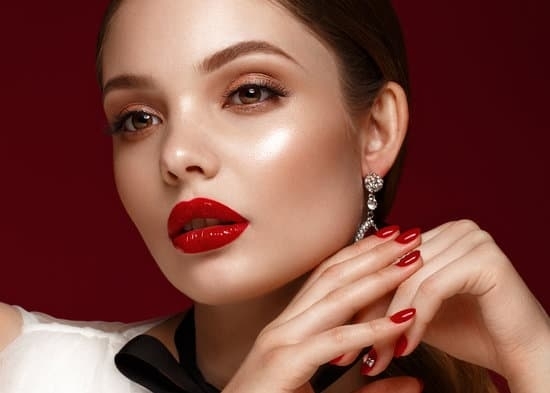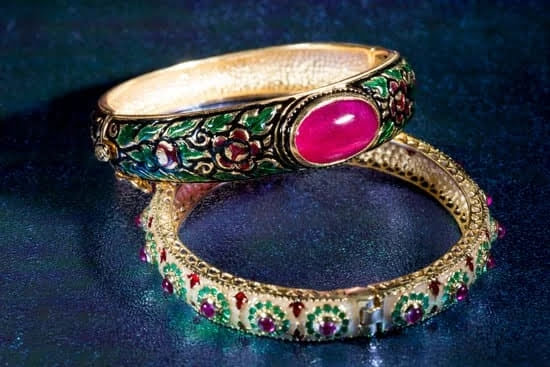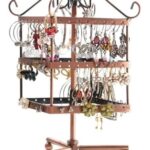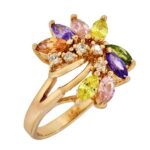Juliana vintage jewelry is one of the most recognizable, sought after brands of costume jewelry and historically significant. Identifying Juliana Jewelry typically involves examining the design or construction method, and recognizing the materials used in making the piece. It is also important to learn about the era during which a piece might have been made as well as identify whether it was produced by D&E (Delizza & Elster), who are credited with producing a large portion of this line.
Design: The Identification Process
Juliana designs relies heavily on opulent glass cabochons, glittering rhinestones and lavish faux jewels often arranged in eye-catching displays of modernist inspired designs. Designers for Juliana used many different combinations of flatbacks, chatons, marquises, rounds and navettes set into textured silver tone metal settings.
Certain characteristics presented in the design such as intricate detailing on leaves and flowers or unfurling scrolls suggest a Juliana piece right away, however there are other parts to recognize that won’t be so easily visible without closer inspection.
Materials: Another Part Of Identification
The metals used range from silver tone plate to pewter and brass metal bases. Many charms were strung together with links made up of tiny tubes that were soldered together. Chains were constructed with jeweler rings sometimes filled with 2-3 pave rhinestones to create a uniquely glamorous look unique to Juliana jewelry collections that expectedly dates from the 60’s – 80’s but which is highly collectable today.
Additionally when looking for marks inside trays look for ETCHED IN BOLD LETTERING ‘JULIANA’ marking because it can establish a date range circa 1950s when D&E Juliana standardized their nomenclature on their pieces. Finally if you find blue rhinestones among other colors that can be another identifier since blue was not commonly found until late 60’s/early 70’s collections when we begin finding bright aqua Simicore stones among their other simulated gems stones.
History of Juliana Jewelry
Juliana jewelry dates back to the 1940s, when DeLizza and Elster started their business in New York City. The popular style of Juliana jewelry reinvented rhinestone costume jewelry from simple, unadorned designs to ornate creations that had multiple colors and beads. Customers were drawn to Juliana’s intricate designs which featured bright colors, aurora borealis rhinestones, and opaline stones set using prong-type settings. During its heyday in the 1950s and 1960s, Juliana jewelry was quite popular throughout the US.
Signature Features
Juliana jewelry pieces are known for having brightly colored navettes, AB chatons (rounded rhinestones), headlight or margarita stones (concave flat-backs). Also prominent features of Juliana items are large aurora borealis beveled baguettes or rectangles with pointed tips. Many of their pieces also feature colorful a glass cabochons that resemble mosaics and tendrils on leafy scroll details that surround an individual gemstone or cluster of gemstones adding touches of realism to their designs.
Manufacture Identification
Identifying your vintage piece requires attention to detail as there are certain characteristics unique to only these pieces; specifically two copyrights they used-©J in a circle which symbolized DeLizza & Elster from 1949-1977 and ©D&E Juliana which was used from 1978-1981. Another telltale sign is the clasp being unfirmly attached with glue so it moves about freely upon inspection.
Since many of the pieces were made before sterling silver became popular you would expect them to be handcrafted from antique gold tones with base metal findings such as japanning and pot metal alloys.
Some expert collectors even use magnifying glass inspections for small raised lettering found on pin stems designating D&E with year markers like “A” for 1959 and “B” for 1960 instead of looking at logos or clasps which may have been replaced at some point during the item’s lifetime.
A last telltale sign is if you find collectible sets, often featuring pins and earring sets which were sold together but were marked differently as they not only came packed in a box but were also signed signed dated on each individual piece typically (on the blue print).
Types & Styles of Juliana Jewelry
Juliana vintage jewelry is a type of costume jewelry that made its debut in the 1940s. It was created by the DeLizza and Elster company, most commonly referred to as D&E. It is named after one of their lead designers, Juliana Hutten.
Juliana Vintage Jewelry is defined by its intricate metal works, bold designs and saturated rhinestones. Often considered to be an influential leader in the costume jewelry world, many of the pieces have been credited as fashion-forward inspirations for other high-end contemporary designers.
One unique style aspect of Juliana Jewelry that sets it apart from other costume jewelry companies of the time is its bright but balanced color palette. The signature look couples vibrant hues such as sapphire blue and ruby red with vintage-inspired cutwork panels and pieces adorned with sparkling rhinestones.
Many iconic pieces within this brand are often completed by inlaid enamel flowers or AB rhinestones which give them a 2-dimensional look when observed from above. Not confined to traditional brooches, Julina Vintage jewelry diversifies itself within its market with styles such as clip earrings that dangle below the jaw line or necklaces that are designed to lay just above the collarbone for a layered effect look.
Popularized within Hollywood’s Golden Age circles, Juliana Vintage Jewelry has become increasingly popular amongst diehard collectors due in part to its availability on popular ground sites like Ebay and Etsy. Pieces have also become seen as collector’s items due to their scarcity given they fall into a pre-owned category since they were only produced between 1944-1971 when production ended due primarily to competition from foreign manufacturers.
Typical pricing of these items requests upwards $100 but can reach upwards $500 depending on maker marks, number identification numbers (often found at the back of pendants) shape and stone size.
Characteristics & Identification Tips for Vintage Juliana Jewelry
Juliana jewelry is some of the most sought after vintage jewelry. It was designed from 1950 – 1980 by DeLizza & Elster, a well-established partnership between two American entrepreneurs. The designs were created with colorful pear-cut glass stones, rhinestones and AB crystals that give the pieces their unique style. Juliana’s jewelry pieces are known for their layered construction, bright colors and ornate design elements.
When looking at vintage Juliana jewelry it’s important to consider certain criteria in order to identify it correctly. Colorful glass stones such as pear-cut or oval-cut glass stones along with rhinestones are sure signs of a Juliana piece. Heavier pieces often contain more layers and intricate details like flowers, petals or filigree.
The signature daisy pattern is featured prominently in many of their designs. Additionally, look for small round hook clasps which were unique to these designs, as well as “J” style findings including cushiony center stones in pointed settings alongside tear drop shaped AB crystals.
Production for the Juliana line stopped around 1980 due to the immense competition from imported items at much lower prices during this era. Look at the markings on the back of your piece as many items were produced between 1960 and 1979 and will likely have manufacturer information stamped into them such as DeLizza & Elster (D&E) or REN for Reinad, who bought the Juliana division from D&E in 1978.
Genuine pieces may also feature trademarks such as JULIANA PT copyright mark or “05” indicating patent pending or issued applications.
Also keep an eye out for customer shops specific marks like REU which was used by Reinad on its products when they purchased the division from D&E in 1978 until 1985 when they closed up shop. When shopping online make sure you can ask questions if needed and examine photos carefully before making any purchases to ensure authenticity.
Price & Value of Vintage Juliana Jewelry
Juliana vintage jewelry is highly sought after by collectors for its unique designs and exquisite craftsmanship. These pieces were designed by DeLizza & Elster in the 1960s and 1970s, making them true vintage pieces. The use of bright colored Austrian crystal stones, along with rhinestones, made Juliana pieces truly stand out and perfect for costume jewelry.
Identifying Juliana pieces can be a bit difficult due to the fact that it is not marked as such. That makes it harder to identify and determine the value of each piece.
The price of Juliana Jewelry can range from a few hundred dollars to several thousand dollars depending on the material used, age, condition and rarity. Pieces can be found at estate sales or even online auctions.
Collectors may find higher prices if they have an original box associated with the piece or if there are multiple matching earrings or matching necklace sets. Pieces featuring ab carriers like flowers and butterflies also tend to be more valuable than other designs because they are rarer.
To determine the value of a piece of vintage Juliana Jewelry, it is important to first identify its materials and details such as whether it has clip-on earrings or screw backs, if it has enamel accents, etc. It is also important to assess its condition – this includes looking for tarnishing or corrosion on metal components which could affect its value significantly.
Lastly, consider provenance when trying to appraise a piece; look into its past owners/generation as some pieces may have historical significance that contribute to increased valuations.
Caring & Cleaning Tips for Vintage Juliana Jewelry
Juliana jewelry is a popular collectable among many vintage jewelry enthusiasts due to its unique design, intricate details and use of beautiful colors. The components used in these pieces included crystals, rhinestones, cabochons, navettes and even beads. To ensure that your Juliana jewelry remains in excellent condition for many years, it’s important to take the proper steps for caring and cleaning your pieces and retaining their original beauty.
One of the best ways to store your Juliana vintage jewelry is to wrap each piece individually before putting them safely away in an airtight container or box with velvet lining or other non-abrasive materials. This helps to protect them from dust or potential scratches that could occur if tucked away with other pieces or thrown loosely in a drawer.
Do not pile several items on top of each other which can cause scratching of the stones or metal components. Make sure any dirty article of clothing that has come into contact with your pieces are laundered first before placing them back into storage.
Before wearing a piece of Juliana vintage jewelry, it’s important that you inspect it closely for any damage. Broken links should be repaired by a professional prior to wearing since they could potentially become worse over time which may result in more costly consequences down the road.
It is also recommended while inspecting the condition of the stones and metal components that you spot clean lightly with a damp cloth as necessary particularly if there appears to be dirt build up present when examined closely.
Be sure never to use acidic household cleaners on any part of your Juliana jewelry since this can strip away the protective coating or tarnish the appearance due to chemical reaction changes made over time when these substances come into contact with certain metals especially gold plating. It is advisable to take your pieces once a year for professional cleaning and repairs when needed as part of routine maintenance care plan.
Using all these measures will help keep your Juliana vintage jewelry looking like new for years.
Shopping Tips for Finding Authentic Vintage Juliana Jewelry
Juliana jewelry is the ultimate collectible for vintage lovers. The Juliana bracelet in particular is a highly sought after piece of jewelry. It stands out from other vintage pieces with its unique four pronged settings and colorful rhinestones and cabochons. Authentic Juliana pieces can be difficult to find due to their age, rarity, and increased popularity among collectors over the years.
When searching for authentically vintage Juliana jewelry, there are a few tips to keep in mind. First, it’s important to recognize the signs of aging that legitimate Juliana pieces will have. Authenticity stamps may have worn off over time, making it difficult to tell if a piece is actually Juliana or not.
Be sure to closely inspect all prongs of the setting as well as closely examine any stone colors and types used on each piece. Additionally, the plating colors on a piece should not be too bright or perfect – they should look like they have aged naturally over time if they are truly authentic pieces.
It’s also helpful to work directly with reputable dealers when looking for original Juliana pieces. Good dealers will be able to provide detailed information about provenance and offer written certificates of authenticity for items that demonstrate genuine vintage origins (you can even contact the seller afterwards for additional verification).
In addition, knowledgeable dealers may provide special discounts for those looking for multiple authentic items at once arising from liquidation sales by estate owners who want to sell off entire collections of antique jewelry at once rather than one piece at a time. This means you can get your hands on some real treasure finds while saving money at the same time.
Wrap Up and Conclusion
Juliana vintage jewelry is an interesting and popular object of conversation. As the name implies, it is a type of jewelry that was produced between the late 1940s and the 1960s. Often referred to as ‘D&E Juliana Vintage Jewelry’ due to its creator’s initials, Delizza & Elster, this glamorous and unique style of jewelry has become increasingly accessible again in recent years offering a great selection for those interested in adding it to their wardrobe or collection.
The most obvious appeal of Juliana vintage jewelry is its unique aesthetic. This style features bright colors like pink, yellow and blue with art glass accents and faux pearls embedded throughout.
Each piece includes a large array of fancy stones like rhinestones and opals plus intricate patterns reminiscent of butterfly wings and floral bouquets. Typically each earring or necklace set comes with matching pieces that come together in order to create a larger design statement; all of which makes each piece incredibly special due to its highly collectible nature.
With interest in vintage jewelry on the rise, another fabulous aspect of Juliana vintage jewelry is the lasting quality for long term use or investment possibilities for future resale potential against other antique styles. The beautiful colors bring life into any wardrobe no matter what age you are, making it timelessly stylish for anyone looking to complete their outfit with a fascinating flourish that will always be noticed by admirers wherever it is worn.
Styled as stand-alone pieces or part of an entire ensemble, there can be no doubt this is an accessory that adds real charm today as much as when it was created during mid-century modernism.

Welcome to my jewelry blog! My name is Sarah and I am the owner of this blog.
I love making jewelry and sharing my creations with others.
So whether you’re someone who loves wearing jewelry yourself or simply enjoys learning about it, be sure to check out my blog for insightful posts on everything related to this exciting topic!





